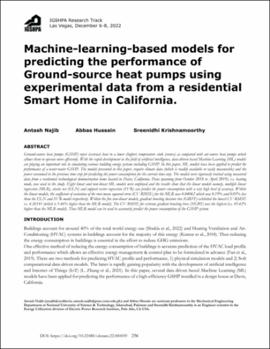| dc.contributor.author | Najib, Antash | |
| dc.contributor.author | Hussain, Abbas | |
| dc.contributor.author | Krishnamoorthy, Sreenidhi | |
| dc.contributor.other | IGSHPA Research Track (2022) | |
| dc.date.accessioned | 2022-12-04T21:58:18Z | |
| dc.date.available | 2022-12-04T21:58:18Z | |
| dc.date.issued | 2022 | |
| dc.identifier | oksd_igshpa_2022_najib | |
| dc.identifier.uri | https://hdl.handle.net/11244/336837 | |
| dc.description.abstract | Ground-source heat pumps (GSHP) reject (extract) heat to a lower (higher) temperature sink (source) as compared with air-source heat pumps which allows them to operate more efficiently. With the rapid development in the field of artificial intelligence, data-driven based Machine-Learning (ML) models are playing an important role in simulating various building energy systems including GSHP. In this paper, ML models have been applied to predict the performance of a water-water GSHP. The models presented in this paper, require climate data (which is readily available or easily measurable) and the power consumed in the previous time-step for predicting the power consumption for the current time-step. The models were rigorously trained using measured data from a residential technological demonstration home located in Davis, California. Data spanning from October 2018 to April 2019), i.e. heating mode, was used in the study. Eight linear and non-linear ML models were employed and the results show that the linear models namely, multiple linear regression (MLR), elastic net (ELN) and support vector regression (SVR) can predict the power consumption with a very high level of accuracy. Within the linear models, the coefficient of variation of the root mean squared error (CV-RMSE) for the MLR was 4.04062 which was 0.19% and 0.05% less than the ELN and SVR model respectively. Within the five non-linear models, gradient boosting decision tree (GBDT) exhibited the lowest CV-RMSE i.e. 4.26141 (which is 5.46% higher than the MLR model). The CV-RMSE for extreme gradient boosting trees (XGBT) was the highest (i.e. 45.42% higher than the MLR model). Thus MLR model can be used to accurately predict the power consumption of the GSHP system. | |
| dc.format | application/pdf | |
| dc.language | en_US | en_US |
| dc.publisher | International Ground Source Heat Pump Association | |
| dc.rights | In the Oklahoma State University Library's institutional repository this paper is made available through the open access principles and the terms of agreement/consent between the author(s) and the publisher. The permission policy on the use, reproduction or distribution of the article falls under fair use for educational, scholarship, and research purposes. Contact Digital Resources and Discovery Services at lib-dls@okstate.edu or 405-744-9161 for further information. | |
| dc.title | Machine-learning-based models for predicting the performance of ground-source heat pumps using experimental data from a residential smart home in California | |
| osu.filename | oksd_igshpa_2022_najib.pdf | |
| dc.identifier.doi | 10.22488/okstate.22.000039 | |
| dc.type.genre | Conference proceedings | |
| dc.type.material | Text | |
